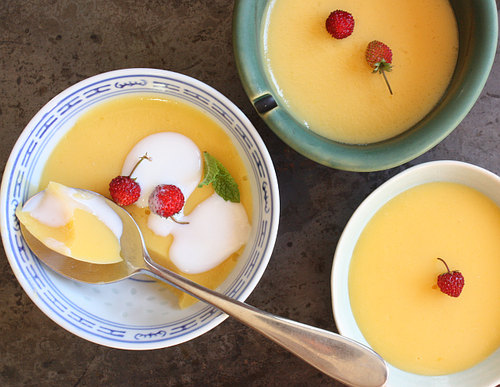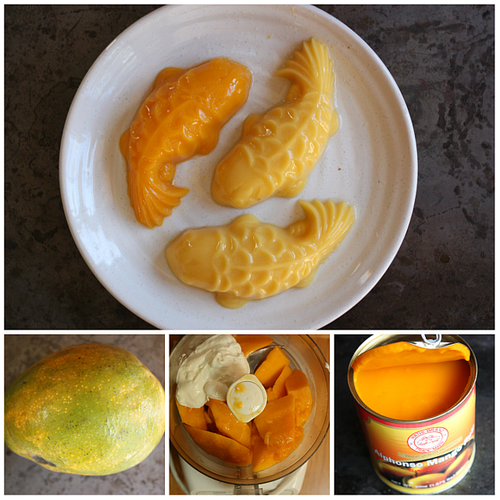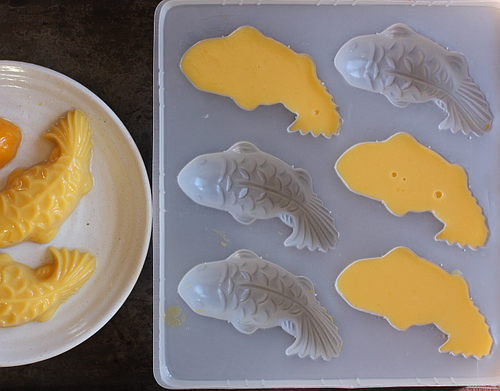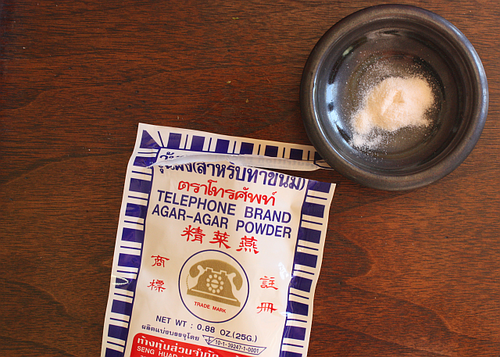
Last Friday we went to a Burmese restaurant in Daly City
that was just fabulous. We ordered way too much food at Little Yangon that
there was little room for dessert. After a lengthy conversation with chef/owner
Khinn Ma Ma, we realized that our parking meter was nearly out and hurriedly
asked for the check. She promptly responded but also sent us off with a
complimentary mango pudding to “sweeten our palate.” It was gelled with agar so
the texture was very firm. Flavorwise, it was delicately sweet – much like the
mango pudding that you get at dim sum restaurants, which I seldom order. Such mango puddings are
often made with evaporated milk, which kind of deadens the fresh brightness of mango.
After I had a few bites, I thought about making my own, without evaporated
milk.
If you’re not familiar with mango pudding, it has British colonial roots in India but is
super popular tropical Asia, though it’s not a major deal in Vietnam. Sometimes
the pudding is soft like a custard but
while other times it is super firm like jello. The former is generally
thickened with cornstarch while the latter is gelled with agar agar or
gelatine. I like the firm, jello-like texture but admit that it's not a luscious pudding per se. However in the Asian mindset, this sweet snack hails from the pudding family but got changed along the way to fit local situations.
Given the Indian roots, I decided to make a pudding that had
echoed a bit of mango lassi but gelled with agar agar, a seaweed based gelatinizing agent that’s super popular
in East and Southeast Asia. Agar agar is vegetarian and will set liquids at
room temperature. (Very cool and
convenient.) The telephone brand of powdered agar agar is stocked at most
Chinese and Southeast Asian markets.
For the mango, I tried fresh
and canned. The giant Keitt mango (mine weighed 1 ½ pounds!) is sweet and
virtually stringless. Canned sweetened mango puree from India is crazy good and
burnt orange in color. It’s usually sold at Indian markets and labeled
according to mango breed. Alphonso and Kesar mangos are terrific. The cans are big but you can keep leftover
puree refrigerated for days after opening.
This photo of the mango pudding casted as lucky koi fish shows the color difference between fresh and canned mango:

The canned mango had a more intense flavor, due to the Alphonso mango's flavor. But the Keitt fresh mango was very good and more accessible!
As a little fun note,
I dug up a koi fish gelatin mold purchased in Melbourne a few years back and
poured the mango mixture into it. The result was lucky mango gold fish:

Asian jello/agar agar molds are often sold at restaurant and
houseware shops in Chinese and Southeast Asian neighborhoods. Or, just eat the
mango pudding from a rice bowl. I had some tiny frais de bois strawberries in
the garden and topped mine with it. Buttermilk imparted a nice tang that I
like.
Additional tweaks:
Instead of yogurt, you could probably
use coconut cream for a vegan approach. If you don’t have agar agar, use 1 ½
teaspoons gelatine and heat with the water over low heat, whisking, until
dissolved; refrigerate, uncovered, to firm up.
RECIPE
Mango Pudding
Yield: Makes about 6 servings
Ingredients
- 1 pound / 450 g fresh mango flesh, or 2 cups / 480 ml canned
sweetened mango - ½ cup / 120 ml Greek yogurt, full or 2 % fat
- About ⅔ cup / 4.67
oz / 130 g sugar - 1 to 3 tablespoons lightly packed dark brown sugar
- 2 to 3 teaspoons fresh lime juice
- 1 ¼ cups / 300 ml lukewarm water
- 2 teaspoon agar-agar powder
- Optional garnishes: Cream/buttermilk/coconut milk, diced
fresh mango, strawberries, fresh mint
Instructions
- If using fresh mango, process or blend it with the yogurt
until smooth. Pass through a coarse mesh strainer positioned over quart (liter)
size measuring cup, stirring with a spatula. Discard stringy bits. If using
canned sweetened mango, just put it into the measuring cup. - Regardless of mango type, sweeten it with the regular and
brown sugar. Add the granulated sugar by the ¼ cup (1.75 oz / 50 g) and brown
sugar by the tablespoon. Make it sweeter than you’re comfortable with because
it will be diluted by the water later on. Add lime juice to brighten the
flavor. Set aside. - Find some rice bowls or the like, or molds to gel the mango
pudding in. You’ll have roughly 3 ½ cups (840 ml) to deal with. Set by the
stove. - Put the water in a
saucepan. Sprinkle on the agar agar. Bring to a boil over medium-high heat,
whisking constantly, to dissolve the agar agar. Turn off the heat, pour in the
mango mixture, whisking to combine well. Pour the mixture back into the
measuring cup for easier portioning. - With little hesitation, divide the mango between your bowls
or molds. If you like, push surface bubbles to the side. Set at room
temperature to cool and firm up, 1 to 2 hours. Cover and refrigerate
afterwards. Serve slightly chilled or at room temperature. Top with a drizzle
of cream, buttermilk or coconut milk if you want a rich touch. Add the fresh
fruit for flourish and color. Eat with spoons.


















Suzette says
I absolutely heart mango pudding! I froze mango chunks earlier this year when they were on sale and ripening faster than I could eat them, so I will definitely give this a try! I've only had it with evaporated milk drizzled on top (not necessarily made with evaporated milk) but coconut milk sounds even better! Thanks!
leah says
Hi Andrea, I remember Mark Bittman using silken tofu to make chocolate pudding. I think it will work really well in this recipe as a substitute for the yogurt. What do you think?
Chris says
Great recipe that Ill have to try out. I love those molds you have.
A little tip on getting rid of the bubbles that form after pouring into the molds is to use a brule torch (if you have one handy). The bubbles pop instantly and you end up with a perfectly smooth surface to set.
Andrea Nguyen says
Brilliant idea, Suzette for using frozen mango! I imagine that the texture will be a tad softer with the evaporated milk or coconut milk.
Andrea Nguyen says
I was thinking that you could use silken tofu too. If you've got Asian Tofu, see the tofu blancmange recipe in the sweets chapter. It would be somewhat similar!
Andrea Nguyen says
I love your pyrotechnics. I don't have a brule torch but do have lighter sticks. Not really the same, eh? Thanks for the tips.
Vijitha says
Hello Andrea,
I am so glad that I found your blog. I am a huge fan of vietnamese food. My friend who owns a Salon in San Jose introduced me to this beautiful cuisine. I have been experimenting its delicacies in my kitchen for the last few months. I briefly browsed through your posts and I am sure that I will be back often to check your recipes. Let's stay connected.
Teresa F. says
I also love love love mango. I had no idea that mango is available canned. What a great idea for making this pudding! The recipe sound delicious and pretty healthy. I also love those koi moulds! So cute. I hope I can find them. They would be great for Lunar New Year!!
Sally Cornaga says
Beautifully presented! My friend Thom has an alternative recipe (condensed milk, agar strands, diced rather than pureed mango). http://theproducesavant.blogspot.com/2013/04/mango-agar-dessert.html
She prefers Ataulfo mango - Andrea, do you have any preferences?
Alana says
Hello I realized you posted recipe years ago but have questions and hoped you’d respond to me? Please. I want to make this exact thing except using canned mango and Gypsum as the coagulant or possibly gypsum and a little tapioca? Please can you give me the recipe with ratios of gypsum instead of agar agar? And would I need to change amount of other things at all? Thank you please if you’re still around let me know???thank you! From Alana
Andrea Nguyen says
Hi Alana, I have only coagulated soy milk with gypsum and tapioca. I have no idea how canned mango would work with those coagulants. Why do you want to do that? Are you allergic to agar agar? If yes, use regular gelatin.
Stella says
Hi, does it make a difference if using Greek and regular yogurt?
Andrea Nguyen says
I doubt it would make a huge difference. Try it and see.
Andrea Nguyen says
I doubt it would make a huge difference. Try it and see what the results would be like. I'd use full fat Greek yogurt, or at least low-fat.